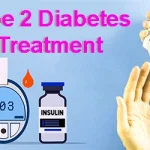Type 2 Diabetes
Type 2 Diabetes Symptoms and Causes: Type 2 diabetes is a chronic condition that prevents your body from effectively using insulin. This type of diabetes primarily affects individuals who are middle-aged or older.
It was previously known as adult-onset diabetes or diabetes mellitus. However, type 2 diabetes is increasingly seen in children and teenagers, largely due to the rise in childhood obesity.
About 1 in every 10 people in the U.S. has it.are diagnosed with type 2 diabetes. Almost 1 in 3 individuals have prediabetes, indicating that their blood sugar levels are elevated but not yet at the threshold for diabetes.
Type 2 Diabetes Symptoms
The signs of type 2 diabetes can be so subtle that you may overlook them. Approximately 9 million individuals are unaware that they have it. Symptoms may include:
- Experiencing extreme thirst
- Frequent urination
- Vision disturbances
- Tingling or unusual sensations in the hands or feet.
- Feeling tired or exhausted
- Injuries that require an extended period to recover.
- Recurring yeast infections
- Constant feelings of hunger
- Unexplained weight loss
- Frequent infections
If you notice dark patches around your neck or underarms, consult your doctor. These patches, known as acanthosis nigricans, can indicate that your body is becoming resistant to insulin.
Types of Diabetes
There are three primary forms of diabetes:
Type 2 diabetes
Approximately 90%-95% of individuals with diabetes have this form. In type 2, the pancreas produces some insulin—the hormone responsible for aiding cells in converting glucose (a type of sugar) from consumed food into energy. In certain individuals, their cells do not adequately respond to this hormone (a condition known as insulin resistance).
Type 1 diabetes
In type 1, the immune system mistakenly attacks and eradicates the insulin-producing cells in the pancreas, causing elevated blood sugar levels. The exact reasons for this occurrence are unknown. Type 1 diabetes is not associated with body weight or lifestyle choices. It was previously referred to as insulin-dependent or juvenile diabetes.
Gestational diabetes
This type of diabetes occurs only during pregnancy. It is a result of hormonal changes and weight gain during this period, which can lead to insulin resistance. Usually, it resolves after childbirth.
Type 2 diabetes typically results from a combination of factors, which can include:
Genetics. Researchers have identified various segments of DNA that influence how your body produces insulin.
Body weight. Carrying excess weight or being obese can lead to insulin resistance.
Metabolic syndrome. Individuals with insulin resistance frequently experience a set of conditions such as elevated blood sugar, increased blood pressure, and higher levels of cholesterol and triglycerides.
Excess glucose production by the liver. When blood sugar levels drop, the liver generates and releases glucose. After ingestion of food, blood sugar levels rise, prompting the liver to usually reduce its glucose output and store it for future use. However, some individuals’ livers continue to produce sugar.
Poor cellular communication. Sometimes, cells may relay incorrect signals or fail to interpret messages accurately. When these issues impact how cells manage insulin or glucose, it can result in diabetes.
Dysfunctional beta cells. If the insulin-producing cells release insulin at inappropriate times, it can disrupt blood sugar levels. Additionally, high blood sugar can also harm these cells.
Type 2 Diabetes Risk Factors
Certain elements increase the likelihood of developing type 2 diabetes. The more of these factors you have, the greater your risk of contracting the disease. It’s beneficial to understand the potential causes of type 2 diabetes, including:
- Age: Being 45 years old or older
- Family: Having a parent, sibling, or child with diabetes
- Ethnicity: Being African American, Alaska Native, Native American, Asian American, Hispanic or Latino, or Pacific Islander American
Medical and health-related risk factors comprise:
- Insulin resistance
- Prediabetes
- Cardiovascular disease
- Hypertension, even if it is managed and controlled
- Low levels of HDL (“good”) cholesterol
- Elevated triglycerides
- Being overweight or experiencing obesity
- Giving birth to an overweight baby.
- Experiencing gestational diabetes during pregnancy
- Polycystic ovary syndrome (PCOS)
- Depression
Additional risk factors associated with your daily routines and lifestyle choices can be modified:
- Lack of physical activity
- Smoking
- High-stress levels
- Inadequate or excessive sleep
Diagnosis and Testing for Type 2 Diabetes
Your physician can assess your blood for indications of type 2 diabetes. Typically, they will conduct tests on two separate occasions to validate the diagnosis. However, if your blood glucose level is significantly elevated or if you exhibit numerous symptoms, a single test may suffice.
Blood tests for type 2 diabetes consist of:
A1c test. This represents the average percentage of your blood glucose levels over the prior 2 to 3 months.
Fasting plasma glucose test. Also referred to as a fasting blood sugar test, this measures your blood sugar levels after abstaining from all food and drink, except for water, for a period of 8 hours before the test.
Oral glucose tolerance test (OGTT). This evaluates your blood glucose levels both before and 2 hours after consuming a sugary drink to determine how effectively your body manages the sugar.
Stages of Type 2 Diabetes
Researchers have identified four phases of type 2 diabetes:
Insulin resistance
During this phase, your body typically produces sufficient insulin to maintain blood sugar levels within the normal range. However, if your cells “resist” the insulin by not utilizing it properly, your body will generate additional insulin to facilitate the entry of glucose into those cells.
Insulin resistance can be momentary, but it can also persist. Since there is no specific test for insulin resistance, diagnosing it can be challenging.
Prediabetes
Insulin resistance eventually results in increased glucose levels in your bloodstream. You are classified as having prediabetes when your blood sugar readings are above the normal range but below the threshold for diabetes.
Although you might not experience any symptoms, having prediabetes increases your likelihood of heart disease, stroke, and type 2 diabetes.
Type 2 diabetes
If your A1c level is 6.5% or greater, you are diagnosed with diabetes. You could experience symptoms such as increased thirst, blurred vision, and tingling or numbness in your feet or hands. Alternatively, you may not show any symptoms at all.
Type 2 diabetes with vascular complications
At this point, your diabetes has resulted in complications affecting your blood vessels. You may experience damage to the blood vessels in your eyes (retinopathy), kidneys (nephropathy), and certain nerves (neuropathy). Additionally, you might face heart disease, stroke, or problems with circulation.
Conclusion
Type 2 diabetes is a significant health condition that necessitates ongoing management throughout your life. Losing weight, adopting a healthier lifestyle, and using medications when necessary can assist you in maintaining control over the condition. Each of these strategies can contribute to a longer, healthier life.





